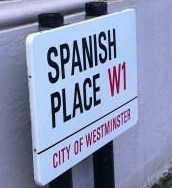
One of my favourite things about Spanish genealogy is the sheer level of detail included in civil and parish records. When you’re trying to identify migrants, the goal is always to match them up with records in their home country, and Spanish records are incredibly valuable in this regard. This is partly because they so often provide up to three generations’ worth of biographical information and partly because Spanish women haven’t historically changed their names on marriage so they usually include birth surnames for all the women, which makes this old feminist’s heart very happy. In today’s blog, I’m going to walk you through an example of a civil birth record from FamilySearch’s wonderful (if slightly chaotic) collection Spain, Province of Cadiz, Municipal Records, 1784-1956.
Our example record is the birth of Carmen Blanco Larruscain. She came into my research because her parents, José Maria Blanco and Bibiana Larruscain, met and married in London, where they both worked as servants. At the time of the 1841 census, Bibiana was working for the Mexican merchant Francisco de Lizardi in Gordon Square, Marylebone. Also in the household was Maria Ybarzabal Larruscain, Bibiana’s 10-year-old daughter from her first marriage. When José Maria and Bibiana married at the Roman Catholic Lady Chapel in Marylebone on 16 September 1845, José Maria’s occupation was given as servant (although we don’t know who his employer was). By the time their son Antonio was born in January 1849 the couple had returned to Spain, settling in the southern port city of Cádiz where Carmen too was born six years later.


Carmen’s birth was registered in the city’s civil register, one of four entries on the page spanning the week of 4-10 July 1854.1 Until 1871 Spain had no national civil register of births (or marriages or deaths), although from 1841-1870 some larger places – like Cádiz – kept their own records. Above is the FamilySearch scan of the cover of the large, hardback volume where Carmen’s entry is recorded, together with the scan of the page (Carmen’s entry is bottom right). As you can see, this is a printed book, so all the entries follow the same format. That said, individual registrars could put their own stamp on things – this one apparently wasn’t bothered with filling in the ‘Número’ or ‘Number’ for each entry, which would have been helpful when it comes to citing this entry as a source!

The first section of the form record the details of the birth, which reads:
- Cadiz. Nacimiento de / Birth of M[ari]a del Carmen
- El dia 10 del corriente / Day: 10 inst. (i.e. of the present month)
- A la hora de las 4 de la mañana / Time: 4 in the morning
- En la calle de / Street: la Alameda
- Num / No. 60 [cuarto / apartment is left blank]
- Es hijo de matrimonio / Child of a married couple
From this, we learn the precise time, date and place of Carmen’s birth, and also that her parents were legally married. There is no Calle de la Alameda in Cádiz today, but the address may refer to the Alameda Apodaca, now a coastal promenade separating Cádiz old town from the shore (more research needed here!). You can see a 19th-century photo of it at the top of this post.

The next section of the record (above) records the details of Carmen’s padres/ parents, including their full names and pueblo de su naturaleza / town of birth with its provincia / province. Here we learn that D. José M[ari]a Blanco was a Galician, born in Villagarcia [today Vilagarcia de Arousa] in the province of Pontevedra and D. Bibiana Larruscain was Basque, born in Eibar in the province of Guipuzcoa.2 This is information we couldn’t get from any of the British records where the family appear!

Now comes one of my favourite aspects of Spanish recordkeeping, because after the parents’ details comes … the abuelos or grandparents! Unfortunately our civil registrar was a bit lazy filling in this entry – he didn’t record the grandfathers’ full names, and he didn’t list any places of birth (although he did for all the other entries on the page). Nonetheless, we can learn that Carmen’s abuelos paternos / paternal grandparents were Juan [Blanco] and Manuela Núñez, while her abuelos maternos / maternal grandparents were Andrés [Larruscain] and Fran[cis]ca Larchangar[?]u.3

The final section of the entry includes information about Carmen’s baptism: Se bautiza en la parroquia de / Baptised in the parish of El Rosario on 12 de Julio/July. El Rosario, or more properly the parish of Nuestra Señora del Rosario, is a grand 18th-century church tucked away in a narrow street in Cádiz old town (in fact, the street is so narrow it’s almost impossible to get a decent exterior photo of the church!). The photos below, from various sources, will give you an idea of its simultaneously austere and riotous interior, which is likely very little changed from the day of Carmen’s baptism almost 170 years ago.



Carmen’s birth record is a very typical example of Spanish civil record-keeping in the mid 19th century, which I hope has provided an insight into the structure and level of detail to be found in this kind of record (notwithstanding this particular registrar’s minor derelictions of duty, grrr…).
- ‘Carmen Blanco Larruscain.’ 10 July 1854. Nacimientos, vol. 6020, 1854 abr-1855 ene. [no pagination]. Spain, Cadiz, Cadiz, registro civil. http://www.familysearch.org : accessed 22 September 2023. ↩︎
- The D. is short for ‘Don’ or ‘Doña‘, an honorific or polite form of address. ↩︎
- Cross-referencing with other sources, it appears that Lachangurry was the version of Bibiana’s maternal surname more often used in Basque records. ↩︎
